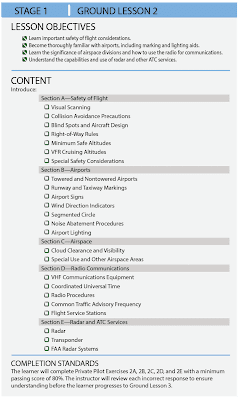Instructors need a practical guide to help them make sure the training is accomplished in a logical sequence and that all of the requirements are completed and properly documented. A well organized, comprehensive syllabus can fulfill these needs.
Syllabus Format and Content
The format and organization of the syllabus may vary, but it always should be in the form of an abstract or digest of the course of training. It should contain blocks of learning to be completed in the most efficient order. Since a syllabus is intended to be a summary of a course of training, it should be fairly brief, yet comprehensive enough to cover essential information. This information is usually presented in an outline format with lesson-by-lesson coverage. Some syllabi include tables to show recommended training time for each lesson, as well as the overall minimum time requirements. [Figure 1]
While many instructors may develop their own training syllabi, there are many well-designed commercial products that may be used. These are found in various training manuals, approved school syllabi, and other publications available from industry.
Syllabi developed for approved flight schools contain specific information that is outlined in 14 CFR parts 141 and 142. In contrast, syllabi designed for training in other than approved schools may not provide certain details such as enrollment prerequisites, planned completion times, and descriptions of checks and tests to measure learner accomplishments for each stage of training.
How to Use a Training Syllabus
Each approved training course provided by a certificated aviation school should be conducted in accordance with a training syllabus specifically approved by the FAA. At certificated schools, the syllabus is a key part of the training course outline. The instructional facilities, airport, aircraft, and instructor personnel support the course of training specified in the syllabus. Compliance with the appropriate, approved syllabus is a condition for graduation from such courses. Therefore, effective use of a syllabus necessitates that it be referred to throughout the entire course of training. Both the instructor and the learner should have a copy of the approved syllabus. However, as previously mentioned, adherence to a syllabus should not be so stringent that it becomes inflexible or unchangeable. It should be flexible enough to adapt to the special needs of individual learners.
Ground training lessons and classroom lectures concentrate on the cognitive domain of learning. A typical lesson might include defining, labeling, or listing what the learner understands so far. Many of the knowledge areas are directly or indirectly concerned with safety, ADM, and judgment. Since these subjects are associated with the affective domain of learning (emotion), instructors who find a way to stress safety, ADM, and judgment, along with the traditional aviation subjects, can favorably influence a learner’s attitude, beliefs, and values.
 |
| Figure 2. A flight training lesson, like a ground training lesson, should include an objective, content, and completion standards. More than one objective could, and often does, apply to a single flight lesson |
The flight training syllabus should include Risk Management instruction unique to each stage, phase, or training element to help the learner identify the risks involved and employ strategies to mitigate them. Throughout the learner’s training scenarios the instructor should include increasingly more subtle risks so that the learner becomes more skilled in identifying them and able to develop effective mitigation strategies. The aviation technician syllabus should also emphasize what constitutes unsafe practices, such as the ease of introducing foreign object damage (FOD) to an aircraft when the location of tools is not monitored.
A syllabus may include several other items that add to or clarify the objective, content, or standards. A lesson may specify the recommended class time, reference or study materials, recommended sequence of training, and study assignment for the next lesson. Both ground and flight lessons may have explanatory information notes added to specific lessons. [Figure 3]
 |
| Figure 3. Information in the form of notes may be added to individual ground or flight lessons in a syllabus when they are necessary |
While a syllabus is designed to provide a road map showing how to accomplish the overall objective of a course of training, it may be useful for other purposes. As already mentioned, it can be used as a checklist to ensure that required training has successfully been completed. Thus, a syllabus can be an effective tool for recordkeeping. Enhanced syllabi, which also are designed for recordkeeping, can be very beneficial to the independent instructor.
 |
| Figure 4. Glider training log |
Another benefit of using a syllabus is that it helps in the development of lesson plans. A well-constructed syllabus already contains much of the essential information that is required in a lesson plan, including objectives, content, and completion standards.

